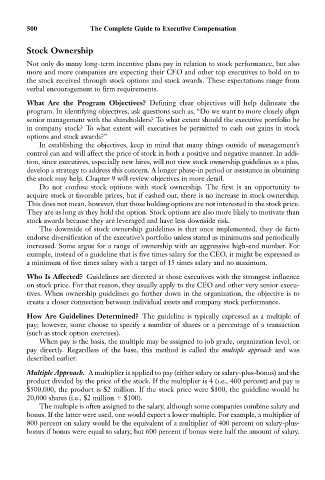Page 514 - Bruce Ellig - The Complete Guide to Executive Compensation (2007)
P. 514
500 The Complete Guide to Executive Compensation
Stock Ownership
Not only do many long-term incentive plans pay in relation to stock performance, but also
more and more companies are expecting their CEO and other top executives to hold on to
the stock received through stock options and stock awards. These expectations range from
verbal encouragement to firm requirements.
What Are the Program Objectives? Defining clear objectives will help delineate the
program. In identifying objectives, ask questions such as, “Do we want to more closely align
senior management with the shareholders? To what extent should the executive portfolio be
in company stock? To what extent will executives be permitted to cash out gains in stock
options and stock awards?”
In establishing the objectives, keep in mind that many things outside of management’s
control can and will affect the price of stock in both a positive and negative manner. In addi-
tion, since executives, especially new hires, will not view stock ownership guidelines as a plus,
develop a strategy to address this concern. A longer phase-in period or assistance in obtaining
the stock may help. Chapter 9 will review objectives in more detail.
Do not confuse stock options with stock ownership. The first is an opportunity to
acquire stock at favorable prices, but if cashed out, there is no increase in stock ownership.
This does not mean, however, that those holding options are not interested in the stock price.
They are as long as they hold the option. Stock options are also more likely to motivate than
stock awards because they are leveraged and have less downside risk.
The downside of stock ownership guidelines is that once implemented, they de facto
endorse diversification of the executive’s portfolio unless stated as minimums and periodically
increased. Some argue for a range of ownership with an aggressive high-end number. For
example, instead of a guideline that is five times salary for the CEO, it might be expressed as
a minimum of five times salary with a target of 15 times salary and no maximum.
Who Is Affected? Guidelines are directed at those executives with the strongest influence
on stock price. For that reason, they usually apply to the CEO and other very senior execu-
tives. When ownership guidelines go further down in the organization, the objective is to
create a closer connection between individual assets and company stock performance.
How Are Guidelines Determined? The guideline is typically expressed as a multiple of
pay; however, some choose to specify a number of shares or a percentage of a transaction
(such as stock option exercises).
When pay is the basis, the multiple may be assigned to job grade, organization level, or
pay directly. Regardless of the base, this method is called the multiple approach and was
described earlier.
Multiple Approach. A multiplier is applied to pay (either salary or salary-plus-bonus) and the
product divided by the price of the stock. If the multiplier is 4 (i.e., 400 percent) and pay is
$500,000, the product is $2 million. If the stock price were $100, the guideline would be
20,000 shares (i.e., $2 million $100).
The multiple is often assigned to the salary, although some companies combine salary and
bonus. If the latter were used, one would expect a lower multiple. For example, a multiplier of
800 percent on salary would be the equivalent of a multiplier of 400 percent on salary-plus-
bonus if bonus were equal to salary, but 600 percent if bonus were half the amount of salary.

